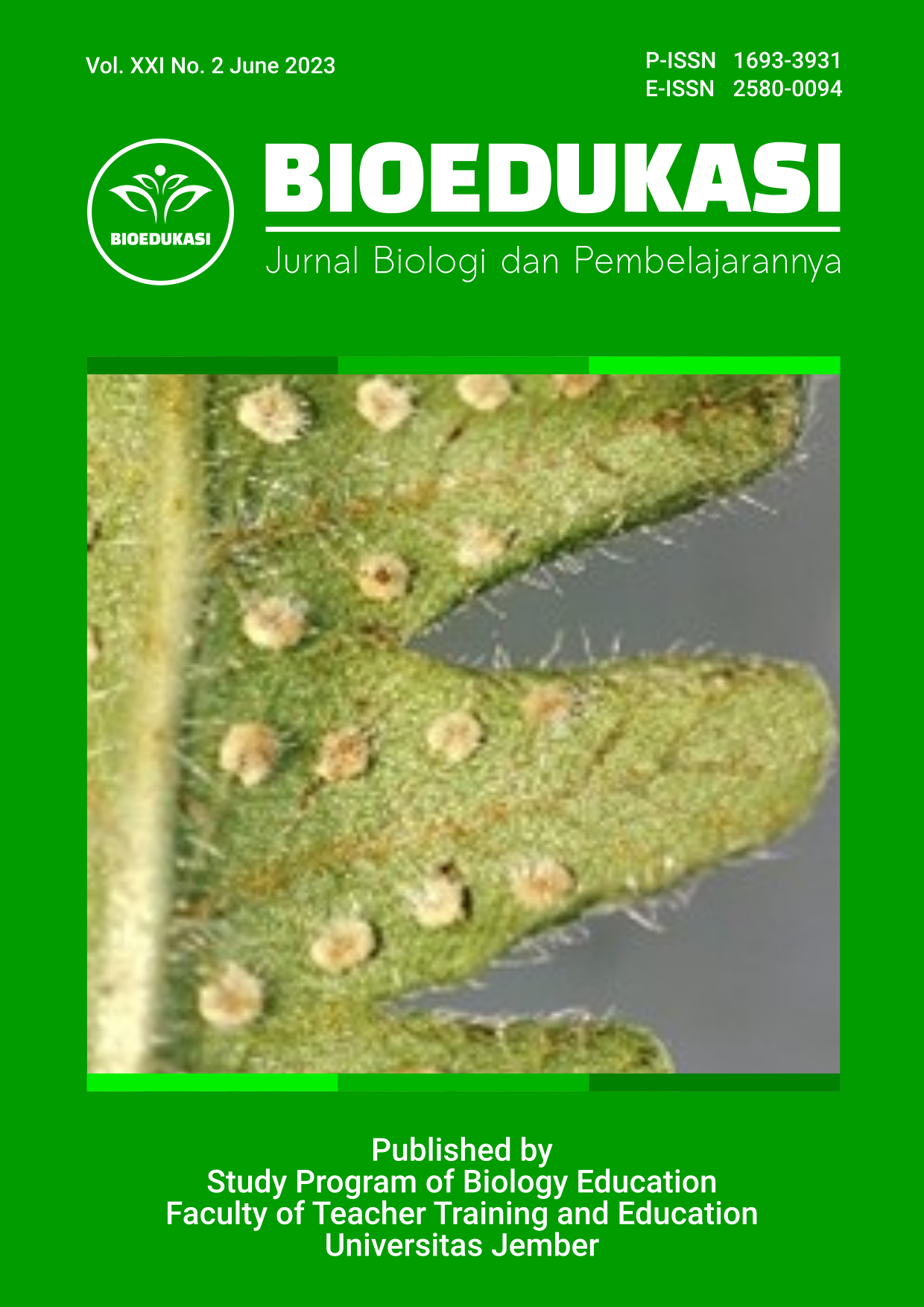Ethnomedicine Study of Medicinal Plants in the Menoreh Salaman Village Community as a Biology Reference Book
Abstract
Utilization of biodiversity, especially plants as ingredients for traditional medicine is a tradition of rural communities in Indonesia. Villagers know traditional medicine from their ancestors which has been passed down from generation to generation. However, knowledge regarding the use of plants for traditional medicine has not been well documented, proving that this knowledge is only mastered by the elderly. Ethnomedicine study is one solution that can be done to overcome this problem. The diversity of plants used by the community for treatment has the potential as a biological reference source. This study aims to identify plants used for traditional medicine by the people of Menoreh Village and to develop and produce a product in the form of a reference book based on the results of the ethnomedicine study conducted. This study uses ethnographic study methods and 4D Research and Development (R&D) models but only up to the develop stage. Collecting data using the method of observation, interviews, and questionnaires. Data analysis techniques using qualitative and quantitative descriptive analysis. The results showed that there were 79 species of plants belonging to 27 orders. The plants most often used are kencur and awar-awar. The most widely used part of the plant is the leaf, the most common processing method is boiling, the dominant way of use is drinking and the disease that is most commonly treated with medicinal plants, namely coughs and colds. good and worth using with revision. The feasibility assessment of reference books by media experts is 74.6% with sufficient eligibility criteria and is suitable for use with revisions. The overall feasibility of reference books obtained an average value of 82.46% with good criteria.
References
Anikan, Danang. (2014). Pembuatan Media Pembelajaran Interaktif Berbasis Komputer Melalui Flip Book sebagai Media Pembelajaran Mandiri pada Mata Pelajaran Seni Tari untuk Siswa SMA/MA. Skripsi, Fakultas Bahasa dan Seni. Yogyakarta: Universitas Negeri Yogyakarta.
Creswell, John W. (2012). Research Design Pendekatan Kualitatif, Kuantitatif, dan Mixed. Yogyakarta: Pustaka Pelajar.
Efremila, Wardeenar, E., & Sisilia, L. (2015). Studio Etnobotani Tumbuhan Obat Oleh Etnis Suku Dayak di Desa Kayu Tanam Kecamatan Mandor Kabupaten Landak. Jurnal Hutan Lestari, Vol. 3(2): 234-246.
Fadini, I., Pudjono, P., & Trisnawati, E. (2023). ANTIBACTERIAL ACTIVITY TEST OF AWAR-AWAR LEAF EXTRACT (Ficus septica Burm. F) WITH n-HEXANE AND WATER FILTERS AGAINST THE GROWTH OF Staphylococcus aureus BACTERIA. Pharmacy Peradaban Journal, 3(1).
Ilhami, A., Diniya, D., Susilawati, S., Sugianto, R., & Ramadhan, C. F. (2021). Analisis Kearifan Lokal Manongkah Kerang di Kabupaten Indragiri Hilir, Riau sebagai Sumber Belajar IPA Berbasis Etnnosains. Sosil Budaya, 18(1). 20-27.
Irmawati. (2016). Etnobotani Tumbuhan Obat Tradisional Pada Masyarakat di Desa Baruga Kecamatan Malili Kabupaten Luwu Timur. Skripsi.
Kasrina, & Veriana, T. (2014). Studi Etnobotani Tumbuhan Obat yang Dimanfaatkan Oleh Masyarakat di Kecamatan Sindang Kelingi Kabupaten Rejang Lebong Bengkulu. Proceeding Biology Education Conference: Biology, Science, Environmental, and Learning, Vol. 11. No. 1:354-359.
Meliki, Linda, R., & Lovadi, I. (2013). Etnobotani Tumbuhan Obat Oleh Suku Dayak Iban Desa Tanjung Sari Kecamatan Ketungau Tengah Kabupaten Sintang. Jurnal Protobiont, Vol 2(3) : 129-135.
Rahma, I. (2010). Hubungan tingkat pendidikan formal orang tua dengan pola pengasuhan balita di desa Menoreh kecamatan Salaman kabupaten Magelang. Jurnal Penelitian Universitas Negeri Semarang.
Retnowati, A., Rugayah, J. S. R., & Arifiani, D. (2019). Status keanekaragaman hayati Indonesia: Kekayaan jenis tumbuhan dan jamur Indonesia.
Rohman, N. A., Qohar, I. A., Puspita, N. T., Harianto, S. P., Winarno, G. D., & Dewi, B. S. (2021). Analisis Keanekaragaman Fauna Study Kasus pada 24 (Dua Puluh Empat) Taman Nasional di Indonesia. Jurnal JOPFE, 9(2), 1-10.
Silalahi, M. (2016). Studi etnomedisin di Indonesia dan pendekatan penelitiannya. Jurnal Dinamika Pendidikan, 9(3), 117-124.
Sumawardani, F., Widayatin, S., & Wardhani, I.P. (2016). Rancangan Program Aplikasi Informasi Ramuan Etnomedisin Obat Tradisional Indonesia Berbasis Android. Jurnal Ilmiah KOMPUTASI, Vol. 15(1), 17-82.
Surata, I.K., Gata, I. W., & Sudiana, I. M. (2015). Studi Etnobotanik Tanaman Upacara Hindu Bali Sebagai Upaya Pelestarian Kearifan Lokal. Jurnal KajianBali, Vol. 5(2), 265-284.
Tapundu, A. S., Anam, S., & Pitopang, R. (2015). Studi Etnobotani Tumbuhan Obat Pada Suku Seko Di Desa Tanah Harapan, Kabupaten Sigi, Sulawesi Tengah. Skripsi.
Thiagarajan, Semmel S.S., & Semmel. (1974). Instructional Development for Training Teacher of Exceptional Children a Sourcebook. Bloomington: Center for innovation on Teaching the Handicaped.

This work is licensed under a Creative Commons Attribution-NonCommercial-NoDerivatives 4.0 International License.









 https://orcid.org/0000-0003-1920-0515
https://orcid.org/0000-0003-1920-0515
